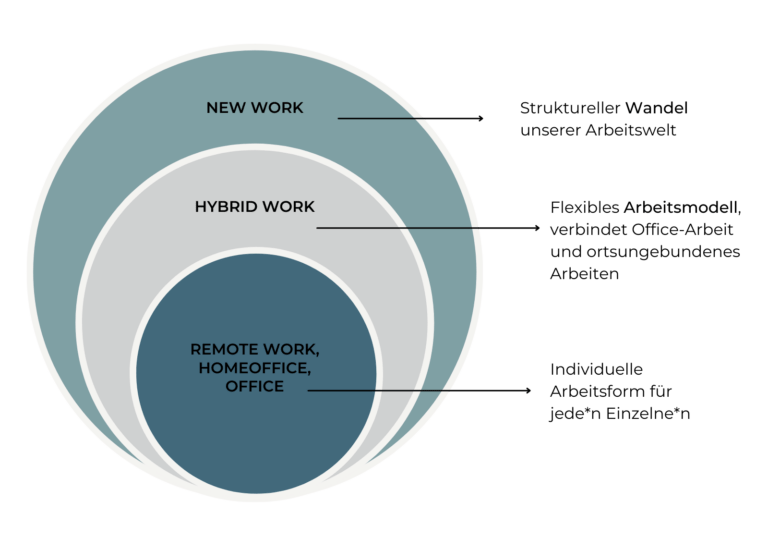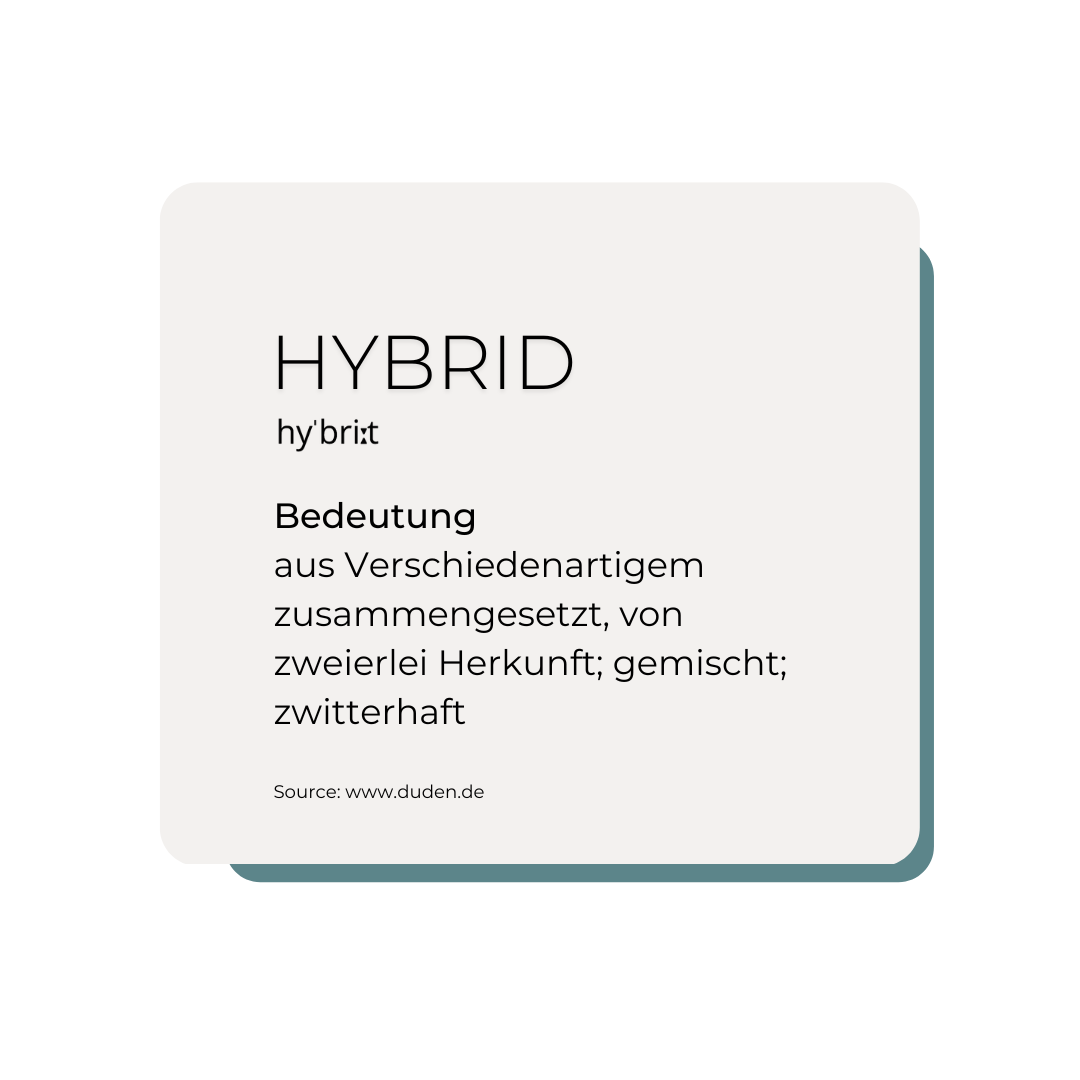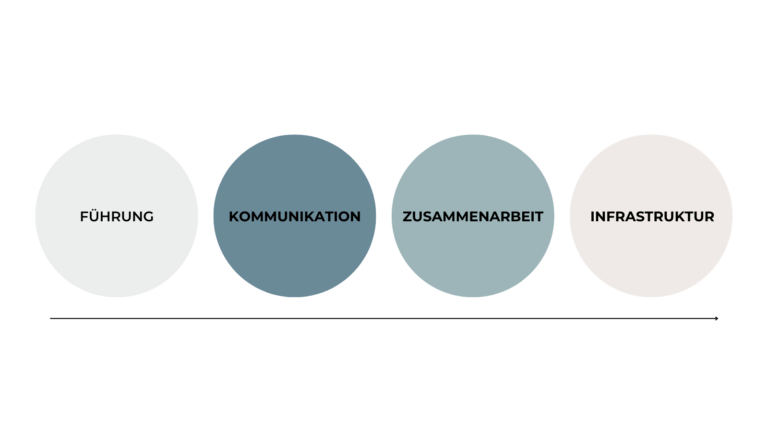
Hybrid work is considered the model of the future of work. The term has become an integral part of any discussion about fundamental decisions in work design. Nevertheless, in this context the most frequently asked question in search engines is: "What is Hybrid Work?" Closely followed by the question of whether hybrid work and new work mean the same thing. So it is high time to clarify the terms and clearly distinguish them from each other.
New Work, Hybrid Work, Remote Work - all the same?
Terms from the New Work bubble are often used synonymously and without sound background knowledge. As a result, the buzzwords hybrid work, remote work and new work are thrown around. Insignificant and even ill-conceived changes in working models, above all the arbitrary specification of two home office days per week, are packaged as the implementation of New Work. The inflationary use of this term causes a lot of confusion - especially for all employees. This makes a clear demarcation all the more important.

New Work
New Work describes the change in the world of work towards more opportunities of development - for example, free development of ideas or more personal responsibility. The term encompasses a whole "toolbox of new mindsets and practical methods. Ideally, New Work helps us to react better and more agilely to external and internal influences. better and more agilely such as generational change, digitalisation and globalisation. As an underlying change in the world of work, New Work cannot be equated with working models or forms of work, such as home office.
Hybrid Work
One of many dimensions of the New Work development is Hybrid Work. As a time and location-independent model, work takes place partly in the office, in the home office or in third locations. The distribution is individual and not constant, but depends on internal and external influences. Hourly models, current projects, need for technical equipment and many other factors influence the composition of office work, home office or work from a third location. Within this work model, flexible and agile teams are put together that can react quickly to internal and external influences and always come together anew. Hybrid work is to be distinguished from remote work, as an office is considered an elementary component of the model.
Home office
Home office refers to working in the employees' own four walls. It is a component of hybrid work and can therefore neither be equated with it nor with remote work. Home office does not automatically mean that employees can work from anywhere. Even legal regulations stipulate a local connection to one's own home. Especially during the pandemic, this form of work became established and is now sometimes described as the "new normal". It should be emphasised here that the establishment of home office days does not yet mean the realisation of hybrid work or even new work.
Remote Work
With Remote Work is working exclusively from home or at a third location. With this form of work, an office is superfluous. Employees are therefore not tied to company offices or home offices. Remote workers can be part of a hybrid work model, but they do not work hybrid.
Basically, it can be said that New Work is a change in the world of work, of which Hybrid Work is one of many dimensions. Hybrid work is a work model that is a mixture of office work, home office and work from remote locations. Home office and remote work are thus manifestations of a hybrid work model. However, they can also exist separately outside of it.
What are the dimensions of hybrid work?
Hybrid work is a flexible working model that is independent of time and place. Employees can work in the office, from home or from a third location. This includes other company locations, customer or supplier sites, coworking spaces, etc. The focus is on where and with whom the work is done. The focus is on where, when and with whom the work can best be done.
A hybrid work model includes all strategies, management tools, communication, collaboration, processes and other infrastructure that enable an organisation, its teams and its employees to work in a hybrid or remote way. Our Hybrid Work Index takes a close look at these dimensions.

In order to make Hybrid Work successful, it requires the design of many areas. Such an all-encompassing concept is complex and does not adhere to departmental boundaries. This makes it all the more important to create a structure. Leadership, communication, collaboration and infrastructure are the dimensions that are covered in the Hybrid Work Assessment.
Leadership
Factors such as leadership skills, purpose, guidance and values significantly shape the transformation of a working model. Managers need to know the skills and strengths of their employees in order to be able to create a flexible and functioning team. Among other things, New Work stands for personal responsibility and free development. This only works if everyone does exactly what he or she can and wants to do.
Communication
Another dimension of hybrid work is communication. Everyone who has been transferred to a home office in the last two years at the latest knows that communication is a challenge in an online work environment. If the communication among each other doesn't work, the team can't work and therefore the work model can't work either. Who communicates with whom and when? How can online meetings be avoided that feel like a mere waste of time afterwards? What is the difference between synchronous and asynchronous communication? These are all questions that organisations have to ask themselves in the course of hybrid work.
Cooperation
Conscious team building, strengthening relationships, motivating exchanges - all factors that have an impact on our cooperation. It may seem to many that the level of collaboration and the importance of teamwork have decreased in recent years, characterised by home offices. If everyone sits in front of their laptops at home, where is there room for interpersonal exchange and team-building impulses? That's right, nowhere. This must change in the future, because in flexible and agile teams, functioning cooperation is actually much more important than when the same constellation of people sits in the office every day and knows each other inside out.
Infrastructure
Hybrid Work is often limited to infrastructure. The conversion of office space is very popular; after all, this is a physical project whose results can be clearly and promptly recognised. However, the other dimensions often receive too little attention - and that is fatal. Because if the change is only visible in external circumstances, it is usually met with less enthusiasm by employees and more with confusion and a lack of understanding. IT infrastructure and office design are important factors for the functioning of Hybrid Work - no question about that. However, at the beginning of such a process, a clear understanding and a new mindset must be created. The order of the dimensions is justified and is reflected in the Hybrid Work Assessment process.
"Only the fundamental transformations of mindset, values and culture are followed by the change in the physical world of work.

The Top 3: Stumbling blocks in the realisation of Hybrid Work
Transformation processes like these are initiated from above. Due to a lack of communication and transparency, changes often lead to a lack of understanding among employees. The perceptions of what needs exist differ fundamentally between employees and managers - perception gaps. Transformations do not take into account the needs of the employees.
Another stumbling block is the complexity of organisations. A transformation that permeates almost all areas appears almost unmanageable in connection with this complexity. This is reflected in alack of factual logic in processes. The red thread is missing. Often, the field is rolled up from behind, namely with the conversion of office space.
This brings us to the next and biggest stumbling block, the infrastructure. Far too often, the focus is immediately on external changes - first a cool table football for the open-plan office. Many organisations have already experienced that this actionism leads to a dead end.
New Work is a change that permeates the entire world of work. Work has to be rethought; this is the only way to create models for the future. The transformation starts with the mindset - of all participants in an organisation.
